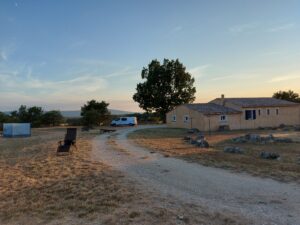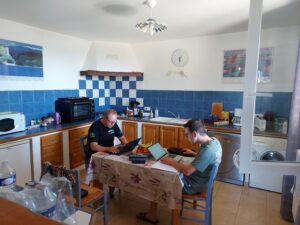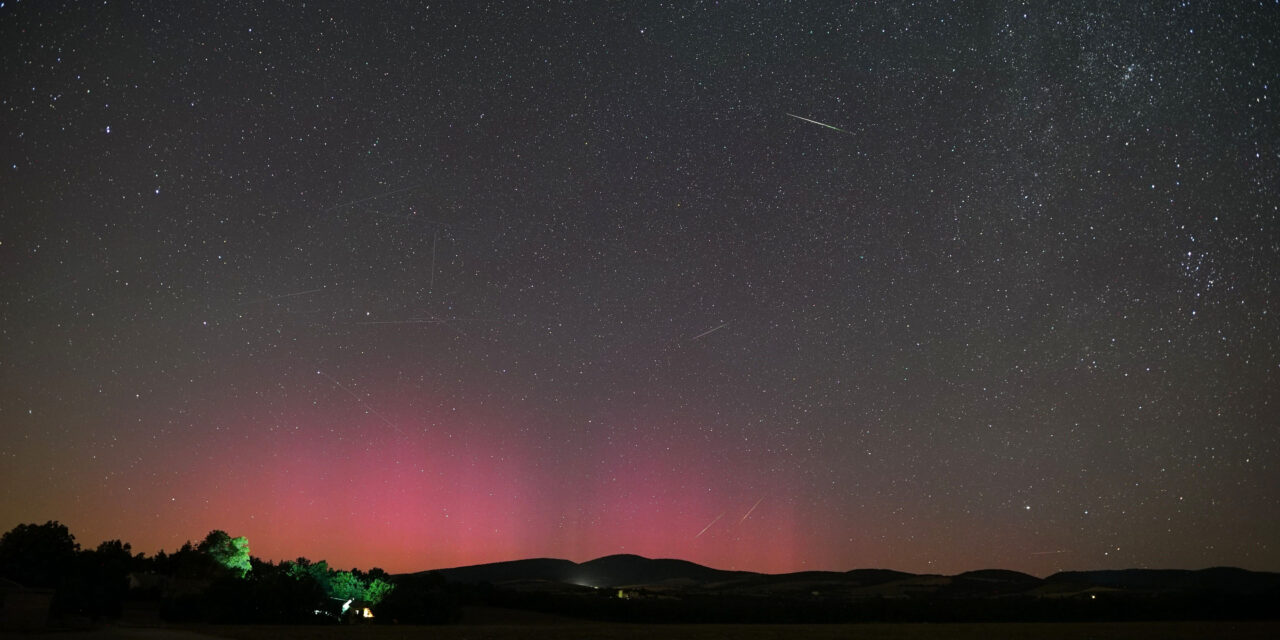Sietse Dijkstra, Carl Johannink, Selma Koelers, Peter van Leuteren & Koen Kiskotte
A report of our visual observations of the Perseids made during a week around the Perseid maximum. The observations were made near Saint Trinit, a small village in the Provence, France. The area is very dark and therefore very suitable for meteor observations and astrophotography.
1 Introduction
The idea for a week of observing the Perseids in the Provence already took shape in the summer of 2023. Reasonably favorable lunar conditions, maximum of the Perseids outside the weekend, good chances on clear skies and the somewhat more favorable holiday options, brought the total number of participating meteor enthusiasts to 6 people. Exactly enough to occupy a house in Saint Trinit. Peter van Leuteren’s family had already stayed there in 2018. According to Peter, the location was ideally suited for observing the Perseids. Selma Koelers, Sietse Dijkstra, Koen Miskotte and Carl Johannink wanted to see that. Initially, Simon Dijkstra, Sietse’s son, was also going to come along, but he was forced to cancel due to an accident in mid-July. A van was arranged for our travel purpose.
The aforementioned quintet finally left Selma Koelers’ home on Friday morning, August 9 at 6h local time sharp for the trip to Provence. The journey on Friday went very smoothly. No traffic jams, and a route via Germany and Luxembourg brought us around 15h local time to our overnight address in Burgundy, called Tournus. This town is only 2 km from the motorway to the south. According to the planning, it would then be another 4 hours’ drive to our spot.
On Tournus we had a simple but good hotel. And enough time to explore this town by walking (Sietse, Koen, Selma and Carl) and by bike in the area (Peter). We met again around half past five in the afternoon on a pleasant square next to the beautiful Romanesque basilica of this town. Dinner was also enjoyed here. After some more site-seeing we returned back to the hotel.
2 August 10, 2024
After a good breakfast with various sandwiches, toppings and other things, we drove out of Tournus around 08h45m for the last four hours… Well at least, that’s what we hoped… But that turned out to be a bit optimistic. After driving 60 km, just before Lyon, a 130 km long ‘stop and go’ stretch began before we could leave the motorway at Orange. We reached Sault, at the foot of Mont Ventoux, fairly quickly via the provincial roads. At the local supermarket, we bought groceries for the weekend, and prepared ourselves for the last few kilometers. At around 16h local time we were welcomed by the owner of the house where we would be staying.
What a beautiful place! A house that was well equipped with all the necessary things for cooking, eating, drinking and cleaning. The house was on the grounds of a sheep farm, a large herd walked in the meadow in front of the house. Then Sietse and Peter started briskly setting up their telescopes and cameras for deep sky and meteor photography. In the meantime, Koen and Carl prepared a macaroni dish with minced meat and vegetables. It was still quite warm at 20h local time. We drank tea or coffee on the terrace of the house. Then everyone went their own way to prepare for the night of observing, either by setting up the equipment or by taking a nap before the start of the observations. Visual meteor observations would be started around 23h UT.

Figure 1 – Our rented house and part of the observing site. © Carl Johannink.
August 10–11
Peter and Koen were the first signing in for the first meteor session. Carl followed shortly afterwards, Sietse and Selma were only finished with all the preparations around midnight, so they napped until roughly 0h UT. Incidentally, Peter had made an improvised fence at the access road to our holiday residence. Two donkeys were walking around freely on the grounds and they might be interested in Peter’s telescope and other equipment that were in the field 24/7.
What did they see? The starry sky was beautiful: the location is very dark and has an unobstructed view between the northwest and east. There was no direct light, except now and then when a car drove on a road a few kilometers north of us. In the southeast and south there are some trees that covered a small part of the sky. The Milky Way was richly structured as expected. The sky was not perfect, by the way, at lower altitudes there were some dust veils and, in the south, some approaching cirrus that largely dissolved when it came closer. Nevertheless, the observers reached limiting magnitudes between 6.4 and 6.5 and SQM readings mostly reaches 21.40 to 21.50.

Figure 2 – Peter and Sietse working on their visual data. © Carl Johannink.
Good activity of the Perseids, interspersed with some beautiful Capricornids, Aquariids and also a sporadic kappa Cygnid. With some regularity a slightly negative magnitude meteor also shot through the firmament, much to the delight of the spectators on the ground.
The activity of the Perseids was good and seemed it was better than in other years. Everyone agreed on that. After more than 3 or 4 hours of observing, dusk set in and the observers ended their sessions for a well-deserved night’s rest, or should we call this morning rest?
August 11–12
Sunday was used to further settle in at the rented house, to process the first data, and for Peter for a bike ride along a number of 3rd category mountains. However, it was quite warm during the day, so Peter admitted he was a bit ‘empty’ after a 2-hour ride.
The night of 11–12 August was clear despite some very thin cirrus clouds and went completely according to expectations: normal Perseid activity, but also with longer ‘quiet’ periods. The highlight was a very beautiful meteor of –2 that slowly moved to the northwestern horizon. This meteor had a strong ‘kappa Cygnid-like’ appearance.
The northern horizon was rather grey in color, which we all noticed. The next day it became clear that there had been a lot of auroras visible in Europe. On images by Peter and Sietse aurora was also visible up to about 15 degrees altitude! The quality of the sky was a lot better than the previous night. We also saw a Starlink train passing through the zenith around 02h05m UT.

Figure 3 – August 12, 2024: promising skies over Saint Trinit. Koen’s equipment is ready for the night 🙂
© Koen Miskotte.

Figure 4 – Composition of 6 Perseids captured during August 11–12, with a Sony Alpha A7 IIs with a Sigma 20 mm ART F 1.4 lens set at 1.6, 3200 ISO, 20 sec exposure time. © Koen Miskotte.
August 12–13
Processing data and doing groceries filled that Monday day. The maximum night of 12–13 August lived up to its name, although the Perseid activity could not reach the level that we had seen in other years. Koen was already in the field early for an all-nighter. The dust veils and the cirrus low south were hardly present after 23h hours. As a result, the half-Full Moon hardly disturbed and the limiting magnitude was soon above 6.0. It is always a special experience for Koen to observe with moonlight. The fact that the landscape is illuminated like a fairy tale gives the night a different experience. This night also no overly bright meteors were seen, the brightest meteors were a few Perseids of –4. Again, a Starlink train was visible, but much weaker than the one of the previous night. And again, aurora has been visible on the northern horizon. Selma, Sietse, Peter and Koen captured this on their camera’s. It was annoying that exactly around the maximum aurora activity a car with a large searchlight drove around the terrain north of our house. Inquiries with the owner of the holiday residence revealed that it was about counting the numbers of hares. If the numbers are too high, they may be hunted. All in all, a nice Perseid maximum with ZHR’s (roughly estimated) between de 50 and 70.

Figure 5 – Composition of 4 Perseids and aurora captured during August 12–13, with a Sony Alpha A7 IIs with a Sigma 20 mm ART F 1.4 lens. Camera set at 2.0, ISO 2000, 20 sec exposure time. © Koen Miskotte.
August 13–14
Tuesday 13 August the weather became unstable during the day. We made a trip to Banon for some sight-seeing and a bite to eat. The cold salmon tartare was a very experimental meal for some, although apparently common in that region. On the way back we regularly stopped for photos to capture the gigantic cumuli. It cleared up again only briefly during the night, and Koen, Peter,Sietse and Selma were still able to observe some meteors and take some deep-sky shots. Too bad it only cleared up briefly, because this night we could look exactly into the same time window in which the intense Perseid outburst (ZHR 230) was observed above North America in 2021. However, the 50-minute clear sky showed normal Perseid activity.
 Figure 6 – Sietse Dijkstra working under a bright sky. Nice composite photo taken by Peter van Leuteren, during the night August 13–14 2024. © Peter van Leuteren, www.blikomhoog.nl
Figure 6 – Sietse Dijkstra working under a bright sky. Nice composite photo taken by Peter van Leuteren, during the night August 13–14 2024. © Peter van Leuteren, www.blikomhoog.nl
August 14–15
Again, a clear sky, but with orographic clouds increasingly visible in the northwest. It was a warm and humid night. Everyone could add some observations to his/her series. This night the nocturnal atmosphere at our observing site was enhanced by a fox, a howling wolf pack, and the peculiar sound of a Scops Owl. We could actually hear the owl ‘singing’ in the background for several hours every night. In addition, there was of course the sound of the Crickets and the bells of the sheep every night. And for the third time, a Starlink train was seen.
August 15–16
On the morning of Thursday 15 August Peter did a ride up the mountain “Montagne de Lure” on his racing bike. The others met him at the top. You have a fantastic view from that mountain to the north! We had lunch together in Sisteron, before we started our way back to Saint Trinit. Later that afternoon we were visited by our friends Michel Vandeputte and Inneke Vanderkerken with their kids Laurien and Boris. It was a pleasant afternoon with coffee, cake, nuts and drinks.

Figure 7 – Group photo! From left to right, Selma Koelers, Sietse Dijkstra, Koen Miskotte, Carl Johannink and Peter van Leuteren.
The following night it only cleared up late at night. Although the viewing conditions were comparable to the previous nights, the zodiacal light was best visible that night. Also, the last meteors were collected that night. On Friday, Selma, Peter and Carl treated themselves to a trip to the Mont Ventoux. Later that afternoon we all enjoyed a sorbet on a terrace in Sault to celebrate our succes with the Perseids 2024. And then time to clean up.
We left early Saturday morning at 04h40m for home. The return trip went smoothly. Without any real traffic jams, we arrived in Enschede around 17h45m. Here everyone went their own way, knowing that we had enjoyed a beautiful week in the Provence.


